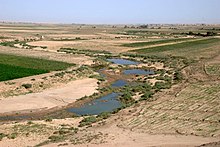Ḫabūrītum
| Ḫabūrītum | |
|---|---|
Goddess of the river Khabur | |
 A modern photo of the river Khabur in Syria. | |
| Major cult center | possibly Sikani |
Ḫabūrītum (
Character
Tonia Sharlach notes that in the past, two possible explanations of the name Ḫabūrītum have been proposed: "the one from the Khabur river [region]" or "the one from [the city] Ḫabura."[2] While individuals from the latter, most likely located in the proximity of modern Al-Hasakah, are attested in documents from the Ur III period, it is generally considered more likely that the goddess represented the river instead.[1][3][4]
Nothing else is known about her character.[3]
Associations with other deities
In Mesopotamia Ḫabūrītum was associated with other deities of western origin, especially
There is evidence that a degree of syncretism occurred between Ḫabūrītum and Inanna, as evidenced by occasional references to offerings made to "Inanna Ḫabūrītum."[7]
Alfonso Archi proposes that Ḫabūrītum can be identified with Belet Nagar, the goddess of Tell Brak, and by extension possibly also with Hurrian Nabarbi ("she of Nawar").[8]
Worship
The cult center of Ḫabūrītum might have been Sikani (si-ga-anki
In the
Documents from the Garšana archive from the indicate that
Other texts also mention sacrifices made by Abi-simti to Ḫabūrītum. One mentions that she sacrificed three fattened
A pair of deities representing the Khabur and possibly related to Ḫabūrītum, Ḫābūr and Ḫabūrtu, appear in a text listing the deities worshiped in
References
- ^ a b Edzard 1972a, p. 29.
- ^ Sharlach 2002, p. 103.
- ^ a b c d Sharlach 2002, p. 104.
- ^ a b c d e Feliu 2003, p. 55.
- ^ Archi 2004, p. 324.
- ^ Sharlach 2002, p. 92.
- ^ Sharlach 2002, pp. 104–105.
- ^ Archi 2013, p. 7.
- ^ Sharlach 2002, p. 114.
- ^ a b Sharlach 2002, p. 94.
- ^ a b Sharlach 2002, p. 105.
- ^ Sharlach 2002, pp. 107–109.
- ^ Sharlach 2021, p. 434.
- ^ Sharlach 2021, p. 433.
- ^ Sharlach 2021, pp. 433–434.
- ^ Feliu 2003, p. 49.
- ^ Feliu 2003, p. 50.
- ^ Feliu 2003, p. 51.
- ^ Sallaberger 1993, p. 107.
- ^ Edzard 1972, p. 29.
- ^ a b George 1992, p. 167.
Bibliography
- Archi, Alfonso (2004). "Translation of Gods: Kumarpi, Enlil, Dagan/NISABA, Ḫalki". Orientalia. 73 (4). GBPress – Gregorian Biblical Press: 319–336. JSTOR 43078173. Retrieved 2022-07-09.
- Archi, Alfonso (2013). "The West Hurrian Pantheon and Its Background". In Collins, B. J.; Michalowski, P. (eds.). Beyond Hatti: a tribute to Gary Beckman. Atlanta: Lockwood Press. OCLC 882106763.
- Edzard, Dietz-Otto (1972), "Ḫābūr, Ḫabūrtu", Reallexikon der Assyriologie (in German), retrieved 2022-07-09
- Edzard, Dietz-Otto (1972a), "Ḫabūrītum", Reallexikon der Assyriologie (in German), retrieved 2022-07-09
- Feliu, Lluís (2003). The god Dagan in Bronze Age Syria. Leiden Boston, MA: Brill. OCLC 52107444. Retrieved 2022-07-09.
- George, Andrew R. (1992). Babylonian Topographical Texts. Orientalia Lovaniensia analecta. Departement Oriëntalistiek. ISBN 978-90-6831-410-6. Retrieved 2022-07-09.
- Sallaberger, Walther (1993). Der kultische Kalender der Ur III-Zeit. De Gruyter. ISBN 978-3-11-013932-7.
- Sharlach, Tonia (2002). "Foreign Influences on the Religion of the Ur III Court". General studies and excavations at Nuzi 10/3. Bethesda, Md: CDL Press. OCLC 48399212.
- Sharlach, Tonia M. (2021). "Local and Imported Religion at Ur Late in the Reign of Shulgi". Ur in the Twenty-First Century CE. Penn State University Press. .
